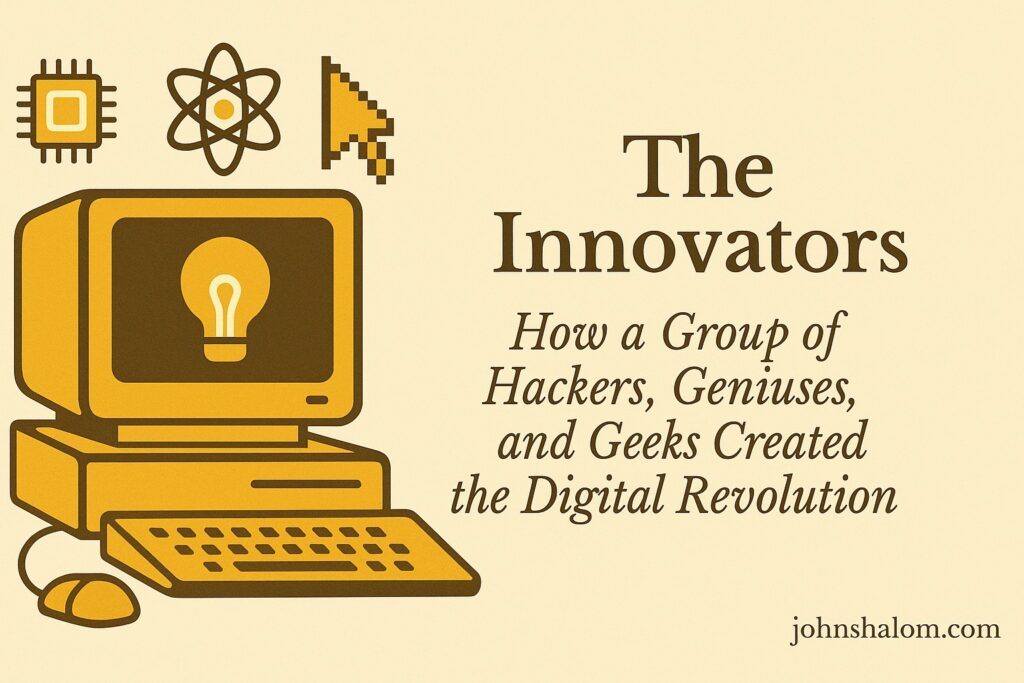
TL;DR:
The digital age wasn’t built by one hero—it was built by a team of dreamers. This story reminded me that innovation thrives where curiosity meets collaboration. From Ada Lovelace to Steve Jobs, every leap in tech began with a simple question: “What if?” The revolution didn’t start with machines—it started with minds.
The digital revolution has transformed our world in ways we could never have imagined. As someone deeply fascinated by technology, I have always been captivated by the stories of the brilliant minds who made it all possible.
“The Innovators: How a Group of Hackers, Geniuses, and Geeks Created the Digital Revolution” chronicles the journey of these extraordinary individuals who shaped the digital era we live in today.
In this article, I’ll share my personal reflections and anecdotes about the key figures and moments that have left an indelible mark on the history of computing.
FAQs: The Innovators: How a Group of Hackers, Geniuses, and Geeks Created the Digital Revolution
1. Who were “The Innovators”?
They were pioneers like Ada Lovelace, Alan Turing, Bill Gates, and Steve Jobs, whose collective work built the foundation of the digital world.
2. What is the main idea of The Innovators?
That technological progress comes from collaboration—not isolation—between inventors, scientists, and creative thinkers.
3. How did collaboration shape the digital revolution?
By combining technical genius with visionary thinking, innovators turned abstract code into real-world transformation.
4. Why is this history still relevant today?
Because it shows that behind every device we use lies teamwork, curiosity, and the courage to experiment.
5. What can readers learn from The Innovators?
That progress isn’t luck—it’s persistence, partnership, and the power of combining art with science.
My Introduction to the Innovators
My journey into the world of technology began with a book. As a teenager, I stumbled upon “The Innovators” by Walter Isaacson in my local library. The book’s captivating narrative and rich historical context drew me in, and I couldn’t put it down. It was my first deep dive into the lives of the visionaries who paved the way for the digital revolution. From that moment on, I was hooked on learning about the incredible contributions of these innovators.
The Pioneers of Computing
The story of the digital revolution begins with the pioneers of computing who laid the groundwork for future advancements.
Ada Lovelace: The Enchantress of Numbers
Ada Lovelace, often regarded as the world’s first computer programmer, was a remarkable figure who foresaw the potential of computing long before it became a reality. Her collaboration with Charles Babbage on the Analytical Engine in the 19th century was nothing short of visionary. Lovelace’s insights into how machines could perform complex calculations and even create art were revolutionary. Her work inspired me to explore the early history of computing and appreciate the contributions of women in technology.
Alan Turing: The Father of Computer Science
No discussion of the digital revolution is complete without mentioning Alan Turing. Turing’s groundbreaking work during World War II, cracking the Enigma code and conceptualizing the Turing machine, laid the foundation for modern computer science. As a college student studying computer science, I was deeply inspired by Turing’s brilliance and perseverance. His legacy continues to influence the field of artificial intelligence and cryptography.

The Birth of the Digital Age
The mid-20th century marked a significant turning point in the history of computing, with the advent of electronic computers and the birth of the digital age.
John von Neumann: The Architect of Modern Computing
John von Neumann’s contributions to the development of the stored-program computer architecture were instrumental in shaping modern computing. The von Neumann architecture, which allows computers to store instructions in memory, revolutionized the way computers operate. Learning about von Neumann’s work helped me understand the fundamental principles of computer architecture and appreciate the elegance of his design.
The Transistor Revolution
The invention of the transistor in 1947 by John Bardeen, Walter Brattain, and William Shockley at Bell Labs marked a pivotal moment in the digital revolution. The transistor replaced bulky vacuum tubes, making computers smaller, faster, and more reliable. This breakthrough paved the way for the development of integrated circuits and microprocessors, which are the building blocks of modern electronics. I remember my excitement when I first learned about the significance of the transistor and its impact on the technology we use today.
The Rise of Personal Computing
The 1970s and 1980s witnessed the rise of personal computing, a transformative period that brought computers into homes and offices around the world.
The Altair 8800 and the Homebrew Computer Club
The release of the Altair 8800 in 1975 is often considered the catalyst for the personal computing revolution. This affordable and accessible computer kit inspired a wave of innovation and enthusiasm among hobbyists and technologists. The Homebrew Computer Club, a group of passionate hackers and tinkerers, played a crucial role in shaping the early personal computing landscape. Reading about the collaborative spirit and camaraderie of the Homebrew Computer Club reminded me of the importance of community and shared knowledge in driving technological progress.
Apple: The Vision of Steve Jobs and Steve Wozniak
One of the most iconic stories in the history of personal computing is the founding of Apple by Steve Jobs and Steve Wozniak. The introduction of the Apple II in 1977 revolutionized the industry with its user-friendly design and powerful capabilities. Jobs and Wozniak’s vision of making computers accessible to the masses resonated with me deeply. Their entrepreneurial spirit and commitment to innovation continue to inspire my own journey in technology.
Microsoft: Bill Gates and the Software Revolution
While Apple was making waves in the hardware space, Microsoft was leading the charge in software. Bill Gates and Paul Allen’s creation of the MS-DOS operating system laid the foundation for Microsoft’s dominance in the software industry. The release of Windows further solidified Microsoft’s position as a tech giant. Gates’ relentless drive and strategic vision were key factors in the company’s success. As a young tech enthusiast, I was fascinated by Microsoft’s rise and the impact of software on the computing experience.

The Internet and the World Wide Web
The advent of the internet and the World Wide Web transformed the way we communicate, access information, and conduct business.
Tim Berners-Lee: The Inventor of the World Wide Web
Tim Berners-Lee’s invention of the World Wide Web in 1989 revolutionized the way we interact with information. The web made it possible to access and share information on a global scale, connecting people and ideas like never before. Learning about Berners-Lee’s vision and the early days of the web was a profound experience for me. It highlighted the power of open standards and the importance of collaboration in driving technological innovation.
The Dot-Com Boom
The 1990s witnessed the explosive growth of the internet, leading to the dot-com boom. Startups and tech companies emerged, reshaping industries and creating new opportunities. The rapid expansion of e-commerce, online services, and digital media transformed the way we live and work. As I reflect on the dot-com era, I am reminded of the excitement and potential of the digital age, as well as the lessons learned from the subsequent bust.
The Mobile Revolution
The 21st century brought about the mobile revolution, fundamentally changing the way we interact with technology.
The Rise of Smartphones
The introduction of the iPhone by Apple in 2007 marked the beginning of the smartphone era. The iPhone’s sleek design, intuitive interface, and powerful capabilities redefined mobile computing. As a tech enthusiast, I vividly remember the moment I first used a smartphone and realized its transformative potential. The ability to access the internet, communicate, and perform tasks on the go was a game-changer.
Android and the Open Source Movement
While Apple led the charge with the iPhone, Google’s Android platform democratized the smartphone experience. Android’s open-source nature allowed manufacturers to create a wide range of devices, making smartphones accessible to a broader audience. The open-source movement, driven by collaboration and innovation, has played a significant role in shaping the mobile landscape. My own experience with Android development has reinforced the importance of open standards and community-driven projects in advancing technology.

Reflections on the Innovators
The innovators who created the digital revolution were driven by curiosity, creativity, and a passion for solving problems. Their stories have left a lasting impact on me, inspiring my own journey in technology.
The Importance of Collaboration
One of the recurring themes in the history of computing is the power of collaboration. From the early days of the Homebrew Computer Club to the open-source movement, collaboration has been a driving force behind many of the greatest innovations. The innovators understood that sharing knowledge and working together could lead to breakthroughs that would have been impossible to achieve alone. This lesson has shaped my approach to problem-solving and underscored the value of teamwork in the tech industry.
Embracing Failure and Learning from Mistakes
The path to innovation is often fraught with challenges and setbacks. The innovators’ willingness to embrace failure and learn from their mistakes was a key factor in their success. Whether it was the early struggles of Apple or the lessons learned from the dot-com bust, the ability to persevere and adapt was crucial. Reflecting on these stories has taught me the importance of resilience and the value of viewing failures as opportunities for growth.
The Role of Vision and Passion
The innovators’ vision and passion for technology were at the heart of their achievements. They were driven by a desire to create something meaningful and impactful. Their unwavering dedication to their goals inspired others to join them on their journey. As I pursue my own projects and aspirations in the tech world, I am reminded of the importance of staying true to my vision and maintaining my passion for innovation.
You might also like: Essential Computer Skills for the 21st Century: From Basics to Advanced Tips
Conclusion
The digital revolution is a testament to the creativity, ingenuity, and determination of a group of hackers, geniuses, and geeks who dared to dream big. Their contributions have transformed our world and continue to shape the future of technology. As I reflect on their stories and the lessons they have imparted, I am filled with a sense of gratitude and inspiration. The journey of the innovators serves as a reminder that with curiosity, collaboration, and perseverance, we can continue to push the boundaries of what is possible and create a better, more connected world.


